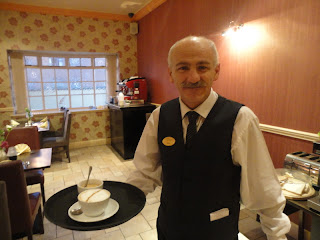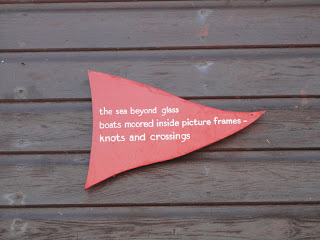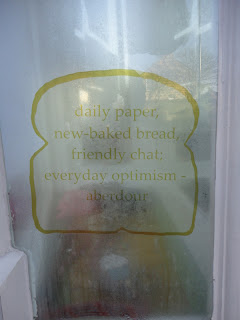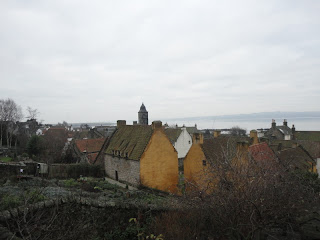Meet Dave, our friendly waiter who greets us each morning:
There's nothing like seeing the smile on his face and hearing the lull of his Scottish accent when we come down for breakfast. Today I asked for pancakes, and I could see the worry in his face at my request. But he came out with a beautifully presented plate with what looked like crepes.They were fabulous! When I told him so, he breathed a sigh of relief, and he admitted to me that this was only the second time that he had ever made pancakes. Believe me, you'd never have guessed that as these were incredibly light and tender. The perfect way to begin the day!
And speaking of perfect, the weather was quite accommodating once again today, with a brilliant blue sky and lots of sunshine. Nary a cloud in the sky to be seen. Thank goodness for that because the temperatures were below freezing and there was an icy coating that lay upon the ground most of the day.
Today's adventure found me in Aberdour. It is just three stations away from Kirkcaldy and all of the trains to Edinburgh stop here. But not all stop in Aberdour. And, it's not that easy to spot the difference. So, I was certain to ask the ticket man if I was on the right train. And, when he assured me that I was, I asked him some questions regarding departing from the train. Well, he was so concerned about me that he actually told me when to get off, and stood near the door to be certain that I made it safely to my location. You can't beat that, can you?
I think that I was the only passenger who hopped off of the train in Aberdour. It is a very small, beautiful town, along the coast of the Firth of Forth. The oldest Scottish Castle continues to stand within feet of the train station. It doesn't get much easier than that when one is traveling alone!
The castle ruins looked lovely with the bright blue sky behind and the frosty grass in front. I headed to the visitor's center to purchase a ticket for admittance to the grounds. The man behind the desk was so thrilled to see a patron, that he popped a sign in the window, locked up the office, and escorted me to St. Fillian's church, behind the castle, for a personal tour of the place.
It was obvious that this man was proud of his history and he pointed out all kinds of details inside the church. This was once a Roman Catholic Church dedicated to St. Fillian and there was an Augustinian order associated with it. Because Aberdour is across the firth from Edinburgh, St. Margaret (whom I spoke of in the Dunfermline post) set up a free ferry from Edinburgh so that pilgrims could travel from that town to Aberdour and then up the coast to St. Andrews, which was a mecca for pilgrims in the past.
I don't know about you, but I certainly found it fascinating to discover just how all of these towns were sort of tied together religiously. I had never realized that there was so strong a connection before. Apparently King Robert the Bruce stayed here, as he had in Dunfermline. Since he wasn't all that popular in his day, he had to be very careful where he traveled.
The church itself dates back to 700. The hall house, part of the castle, dates back to the 12th century, making it the oldest castle in all of Scotland. This man was eager to share that information with me as well. He was delightful and I appreciated him taking the time to show me around. I would have missed a lot of details that he was eager to point out.
One of the features that I have noticed on several scottish castles is the existence of a structure that resembles a beehive.
This is called a dovecot and there are 600+ nests around the interior walls, in tiers. I didn't have the nerve to step down into the dark space, so we'll just have to take the visitor guide's word for that. It housed pigeons or doves, which provided food for the people of the castle. Apparently we can attribute the word pigeon-hole to the dovecot structure. Just a little piece of trivia to add to your day.
Several days ago, I had picked up a brochure entitled Aberdour Poetry Trail. It had a small map for maneuvering around town, and I found the premise to be interesting. Several years ago, a group of local townsmen wrote haiku poems about places in the town that had special meaning to them. Each poem is displayed in a location that the writer was inspired by.
Since brochures of this town are hard to come by, this seemed the perfect way to see the highlights of the town while following a designated map so that I didn't have to worry about getting lost in my travels.
The first poem that I found was outside St. Fillian's chapel. It was difficult to read inscribed in stone:
Peace of earth and sky
a ships bell calling down the years
a pilgrim's rest
Moving along, I was in the bowling green courtyard which joins the castle to the town:
I then headed down towards the firth which was strikingly beautiful today in the sunshine.
Rather clever, don't you think? Then, just along the firth:
On my way out to the old harbor the view to the town was spectacular.
And, when I got to the old harbor, I was taken aback by the huge cliffs that seemed to loom up from nowhere.
A hike back up the hill to the town led me to the local bakery where I found this haiku:
The place was bustling with activity and could I resist the tempting aromas that were teasing my senses? Heck no! So, I popped inside and picked out two very delectable looking treats for later this evening when I can share them with Marty.
Then I headed to the Castle tea room where I ordered the cream tea. The lady told me, quite apologetically, that she didn't have any cream to go with the cream tea. Although I found that to be amusing, I told the lady not to worry and that I was sure that I'd get by without it.
And, just for the record, I managed just fine without it! Yummy!



















































